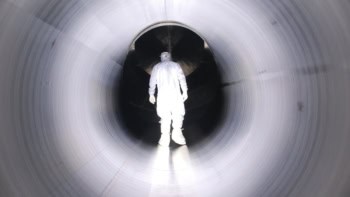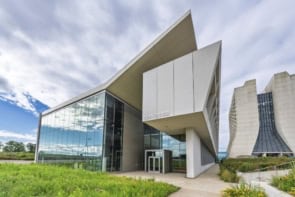
I spent yesterday at the University of Colorado in Boulder at the physics department and JILA, which is a joint institute of the university and nearby NIST — a US government institute that focusses on standards and technology. Unlike my recent visit to NIST, which looked at some of the incredible challenges that have been overcome in order to turn cutting-edge technology into practical devices, yesterday was very much about big ideas in physics.
I spoke with black-hole expert Mitch Begelman about the significance of this week’s unveiling of the first-ever image of a black hole and you can hear that conversation in an upcoming episode of the Physics World Weekly podcast. Begelman also told me about his research doing computer simulations of the magnetic plasmas that surround black holes. These are done on one of the world’s most powerful supercomputers and are providing insight into the extremely violent environment that surrounds black holes and creates the radiation that we detect with our telescopes.

In a warm up to the April Meeting of the American Physical Society, which starts today in Denver and covers particle physics, I spoke to Alysia Marino and Eric Zimmerman (above) about their involvement in neutrino detection experiments including T2K in Japan. In an upcoming podcast you will hear them explain how the humble neutrino could help us solve on of the big mysteries of physics — why is there much more matter than antimatter in the universe?

Boulder is famous for its physicists who study and control systems of ultracold atoms and I was very keen to speak to Jun Ye, who is one of the world’s leading experts on atomic clocks. In an upcoming podcast you will here Ye explain why he is fascinated by the precision timekeepers and what the atomic clocks of the future could look like.
What is the difference between an optical lattice of atoms and an array of atoms held in optical tweezers? Mark Brown, who is doing a PhD in Cindy Regal’s lab at JILA, explained the differences and how atoms trapped in optical tweezers could be used for quantum simulations and quantum computing — stay tuned for more from Brown.
I also spoke to the theorist Jose D’Incao, who is doing calculations that should help his Colorado colleagues (including Nobel prize winner Eric Cornell) create delicate three-atom molecules that can form in ultracold gases. Normally these molecules are a nuisance because they decay quickly and exit the gas, reducing experimental lifetimes. D’Incao wants to study their formation because it could provide important insights into how chemical reactions occur. The molecules are so sensitive to external perturbations such as gravity that they will be studied in an experiment that is now aboard the International Space Station.

And perhaps ending on a more practical note, I had lovely chat with physicist and podcaster Nico Hernández Charpak. That surname sounded familiar so I had to ask — yes, he is the grandson of the physics Nobel laureate Georges Charpak. Hernández Charpak is involved in a programme called STROBE, which aims to transform the imaging science and technology of functioning nanosystems. The problem is that our ability to create nanotechnologies has outpaced our ability to characterize the devices, which he is keen to help solve as Associate Director of Research and Knowledge Transfer for the organization.
I also chatted to Hernández Charpak about his passion for podcasting and LatinoLabs, which is a bilingual podcast he produces in both Spanish and English. So far he has recorded a behind-the-scenes visit to a research machine shop and chatted to scientists working on the Cassini mission to Saturn.



